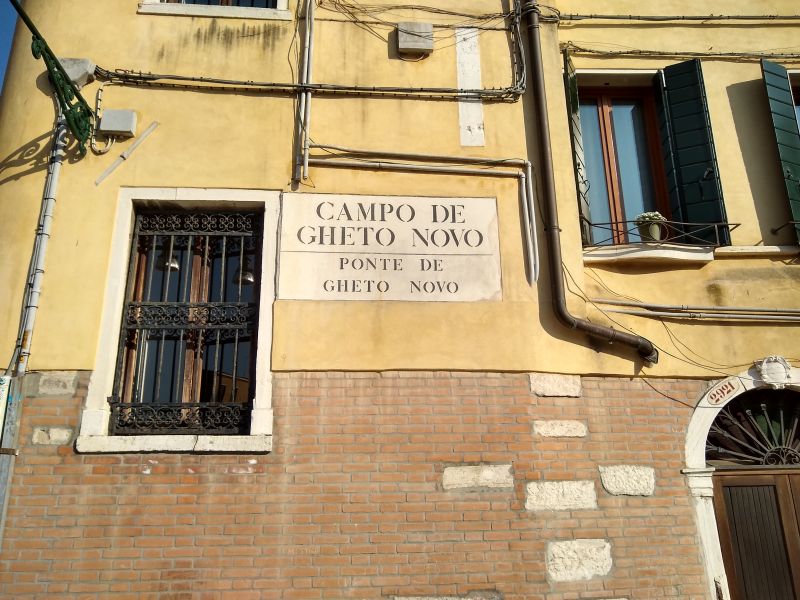Exploring Judaism and Christianity Through a New Lens
By Sasha Rogelberg
 The Jewish quarter in Venice, taken on Drexel Professor Jonathan Seitz’s student trip to Italy | Courtesy of Jonathan Seitz
The Jewish quarter in Venice, taken on Drexel Professor Jonathan Seitz’s student trip to Italy | Courtesy of Jonathan Seitz
March 8, 2023
For as long as there’s been discourse about Christianity, there’s been discourse about its relationship with Judaism.
The topic has been explored through the lens of history, theology and sociology, but Drexel Professor of Philosophy and English Marilyn Piety is taking a different approach. For the past several years, Piety has taught “Judaism and Christianity: Two Religions or One,” part of the university’s Interfaith and Religious Studies program.
“This class is different,” Piety said. “That is, I approach it from a philosophical perspective.”
The course introduces students to a myriad of viewpoints from scholars of different faiths to identify common and separate philosophical ideologies between the religions.
A scholar of Danish theologian Søren Kierkegaard, Piety is interested in the philosopher’s concept of “original Christianity.” Through her scholarship and class, Piety posited some similarities between Jewish and Christian philosophies: “They both have the concept of neighbor love, God is love. They both have a concept of grace. They both have a concept of God working in humanity.”
To contextualize these philosophies, Piety explores the history of the two religions.
“What most of my students don’t understand is that the split between Judaism and Christianity was a long time in developing,” she said.
“Jesus never talks about splitting off and forming his own religion. He was just one of, at the time, many charismatic leaders within ancient Judaism,” Piety added. “Ancient Judaism, just as contemporary Judaism, was very tolerant of a diversity of views and interpretations in religious scripture, and all that. That is something that most students are unaware of, that Christianity was essentially originally a movement from within Judaism.”
Piety developed the course more than five years ago as part of Drexel’s Interfaith Studies program after Jewish Philadelphia philanthropist Laurie Wagman awarded a grant for the creation of the program, which would offer online courses to students, culminating in a certificate. The grant included funding for a video lecture series from The Great Courses, which Piety uses to present diverse philosophical ideas from different scholars. Other courses in the interdisciplinary program include “Introduction to World Religions”; “Coexistence and Conflict: Jews, Christians, and Muslims in the Early Mediterranean”; and “Anthropology of Interfaith Relations.”
One goal of the grant, according to Piety, was to combat growing antisemitism by teaching religious diversity. Drexel did not previously offer many religious courses.
Most of the students in the program aren’t religious but are instead spiritually curious.
Duy Hoang, a 2021 Drexel graduate who studied computer science, took Piety’s course to gain insight into religions more subjectively.
“I was struggling with coming to faith. … I was hoping that I could have an objective, historical view and facts about the Christian religion, the Jewish religion and how they’re related,” he said.
Despite Judaism being a bedrock of the program’s founding and offered courses, none of the program’s three faculty are Jewish. According to Professor of History Jonathan Seitz, who teaches “Coexistence and Conflict,” being Jewish isn’t necessary to teach or experience the program.
“That’s always something that you have to be aware of, and work with when you’re teaching,” he said. “All scholars, I think, have our narrow specialty, but usually when we’re teaching, we’re trying to teach a larger story, larger context. And so, anytime you do that, you’re gonna be working farther from your personal experience, personal knowledge or professional knowledge.”
Seitz leads a student trip to Rome and Venice, Italy, once part of the program but now independent, to explore the Jewish and Muslim quarters and cemeteries of the cities. Experiences such as this help to recontextualize and challenge preconceived notions about religions. So much of religious studies have come from western and American perspectives, skewing the scholarship available.
“We have to approach it with a certain level of humility,” Seitz said of addressing academic biases.
Beyond lectures and final exams, professors within the Interfaith Studies program want to instill deep mutual respect among students of different religions.
“There are important elements in our religions that need to be passed on,” said Douglas Porpora, a sociology professor who teaches in the program.
Porpora is Catholic with Jewish ancestry and is married to a Jewish woman. Though secure in his religious beliefs, the Interfaith Studies program has helped him not only open his eyes to other religious beliefs but to identify and connect with them. The program could have the same effect on his students.
“To know these religions is to de-otherize them,” he said.